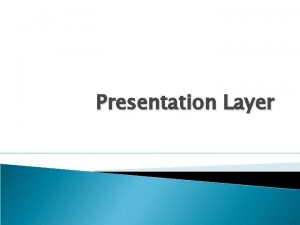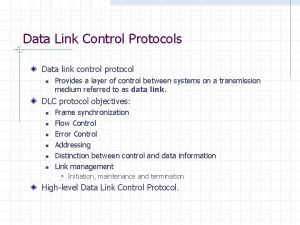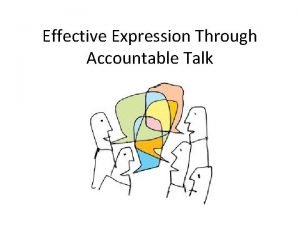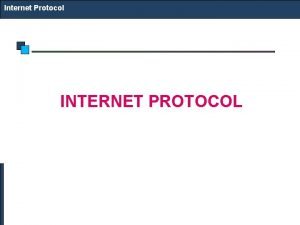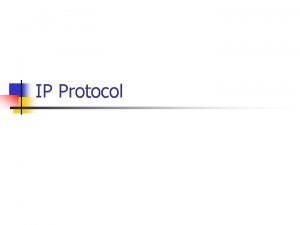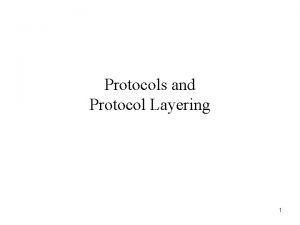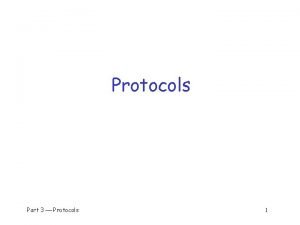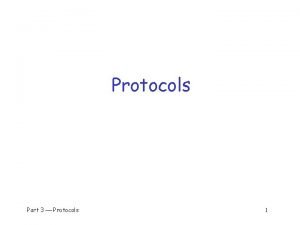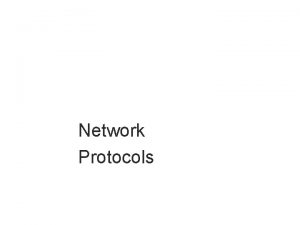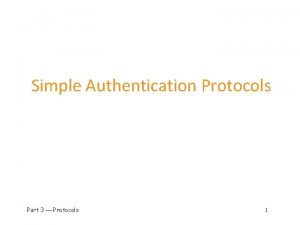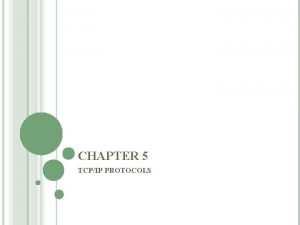PROTOCOLS PROTOCOLS A protocol is a set of























- Slides: 23

PROTOCOLS

PROTOCOLS Ø A protocol is a set of rules that governs communication. Communication between two people or two devices needs to follow some protocol. Ø For example, in a face-to-face communication between two persons, there is a set of implicit rules in each culture that define how two persons should start the communication, how to continue the communication, and how to end the communication.

PROTOCOLS Ø Similarly, in a telephone conversation, there a set of rules that we need to follow. Ø There is a rule how to make connection (dialing the telephone number), how to respond to the call (picking up the receiver), how to greet, how to let the communication flow smoothly by listening when the other party is talking, and finally how to end the communication (hanging up).

PROTOCOLS Ø In computer networks, communication occurs between entities in different systems. Ø An entity is anything capable of sending or receiving information. However, two entities cannot simply send bit streams to each other and expect to be understood. Ø For communication to occur, the entities must agree on a protocol. A protocol defines what is communicated, how it is communicated, and when it is communicated. Ø The key elements of a protocol are syntax, semantics, and timing.

Data Communication System Components

PROTOCOLS: SYNTAX Ø Syntax refers to the structure or format of the data, meaning the order in which they are presented. Ø For example, a simple protocol might expect the first 8 bits of data to be the address of the sender, the second 8 bits to be the address of the receiver, and the rest of the stream to be the message itself. Ø The data order is also applied to the order of bits when they are stored or transmitted. Ø Different computers may store data in different bit orders. When these computers communicate, this difference needs to be resolved.

PROTOCOLS: SEMANTICS Ø Semantics refers to the meaning of each section of bits. Ø How is a particular pattern to be interpreted, and what action is to be taken based on that interpretation? Ø For example, does an address identify the route to be taken or the final destination of the message?

PROTOCOLS: TIMING Ø Timing refers to two characteristics: when data should be sent and how fast it can be sent. Ø For example, if a sender produces data at 100 megabits per second (100 Mbps) but the receiver can process data at only 1 Mbps, the transmission will overload the receiver and data will be largely lost.

PROTOCOLS: ARCHITECTURE Ø Task of communication broken up into modules Ø For example file transfer could use three modules Ø File transfer application Ø Communication service module Ø Network access module

SIMPLIFIED FILE TRANSFER ARCHITECTURE

A THREE LAYER MODEL Ø Network Access Layer Ø Transport Layer Ø Application Layer

NETWORK ACCESS LAYER Ø Exchange of data between the computer and the network Ø Sending computer provides address of destination Ø May invoke levels of service Ø Dependent on type of network used (LAN, packet switched etc. )

TRANSPORT LAYER Ø Reliable data exchange Ø Independent of network being used Ø Independent of application

APPLICATION LAYER Ø Support for different user applications Ø e. g. e-mail, file transfer

PROTOCOLS ARCHITECTURE & NETWORK

Protocols in Simplified Architecture

Protocol Data Units (PDU) Ø At each layer, protocols are used to communicate Ø Control information is added to user data at each layer Ø Transport layer may fragment user data Ø Each fragment has a transport header added Ø Ø Destination SAP Ø Sequence number Ø Error detection code This gives a transport protocol data unit

Protocol Data Units

Network PDU Ø Adds network header Ø network address for destination computer Ø Facilities requests

Operation of a Protocol Architecture


STANDARDS ORGANIZATIONS Ø Ø International Standards Organization (ISO). International Telecommunications Union–Telecommunications Standards Sector (ITU-T). Ø American National Standards Institute (ANSI). Ø Institute of Electrical and Electronics Engineers (IEEE). Ø Electronic Industries Association (EIA). Ø World Wide Web Consortium (W 3 C). Ø Open Mobile Alliance (OMA).

FORUMS Ø Frame Relay Forum. Ø ATM Forum. Ø Universal Plug and Play (UPn. P) Forum.
 Total set awareness set consideration set
Total set awareness set consideration set Training set validation set test set
Training set validation set test set Crisp set vs fuzzy set
Crisp set vs fuzzy set Bounded set vs centered set
Bounded set vs centered set What is the overlap of data set 1 and data set 2?
What is the overlap of data set 1 and data set 2? Fuzzy theory
Fuzzy theory The function from set a to set b is
The function from set a to set b is Crisp set vs fuzzy set
Crisp set vs fuzzy set Remsa protocols
Remsa protocols Channel partitioning vs random access
Channel partitioning vs random access Dicomn
Dicomn The most complex part of tls is the
The most complex part of tls is the Application layer protocols
Application layer protocols Real world protocols
Real world protocols Routing and switching protocols
Routing and switching protocols Clinical assessment protocols
Clinical assessment protocols Presentation layer design issues
Presentation layer design issues Ssv ems protocols
Ssv ems protocols What are two pitfalls (problems) of lock-based protocols
What are two pitfalls (problems) of lock-based protocols Data link control
Data link control Wan technologies overview
Wan technologies overview Accountable talk protocols
Accountable talk protocols Victorian museum
Victorian museum Nyc bls protocols
Nyc bls protocols
















